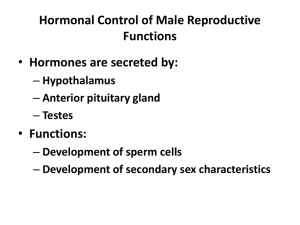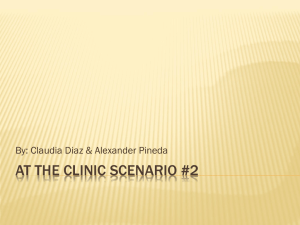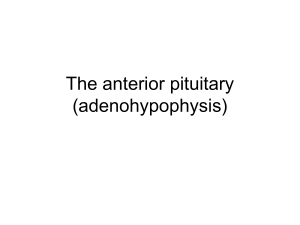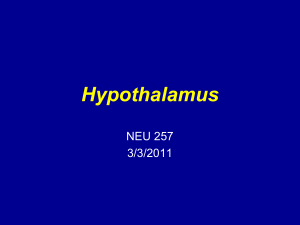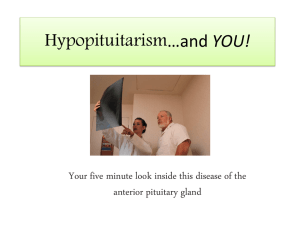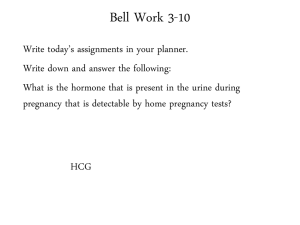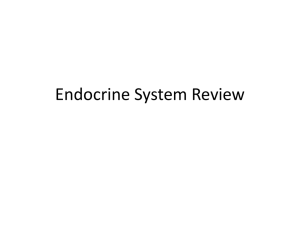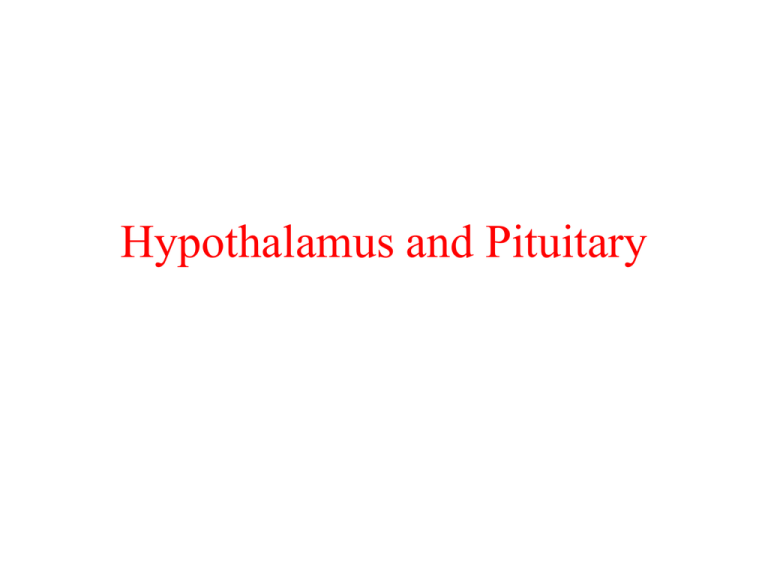
Hypothalamus and Pituitary
Endocrine Control: Three Levels of
Integration
• Hypothalamic stimulation–from CNS
• Pituitary stimulation–from hypothalamic trophic Hs
• Endocrine gland stimulation–from pituitary trophic Hs
HYPOTHALAMUS AND ANTERIOR
PITUITARY LOBE
• The hypothalamic hormones either promote or inhibit
release of the anterior pituitary hormones
Endocrine Control: Three Levels of Integration
Figure 7-13: Hormones of the hypothalamic-anterior pituitary pathway
Characteristics of hypothalamic
releasing hormones
•
•
•
•
•
•
Secretion in pulses
Act on specific membrane receptors
Transduce signals via second messengers
Stimulate release of stored pituitary hormones
Stimulate synthesis of pituitary hormones
Stimulates hyperplasia and hypertophy of
target cells
HORMONES AND THE
HYPOTHALAMUS
The hypothalamus is the major regulatory area for the
internal environment, acting as an interface between
the two control systems, the nervous system and the
endocrine system. As well as controlling the activities of
the autonomic nervous system.
It produces a large number of Releasing hormones
involved directly or indirectly in:
• maintenance of homeostasis
• management of stress, i.e. disturbance of Homeostasis
• determination of the size, shape and sexual
characteristics of the body – morphogenesis.
• NEURAL CONNECTIONS
• The hypothalamus receives information from many
parts of the nervous system. These include
receptor cells which monitor many aspects of the
body’s internal environment:
• pressures in the circulation
• osmotic pressure and the state of the body’s fluid
balance
• composition of the body fluids, e.g. pH, electrolytes,
• glucose
• body temperature
• regulation of food intake.
Hypothalamic releasing hormones
Hypothalamic releasing hormone
Effect on pituitary
Corticotropin releasing hormone
(CRH)
Thyrotropin releasing hormone
(TRH)
Growth hormone releasing
hormone (GHRH)
Somatostatin
Stimulates ACTH secretion
Gonadotropin releasing hormone
(GnRH) a.k.a LHRH
Prolactin releasing hormone (PRH)
Prolactin inhibiting hormone
(dopamine)
Stimulates TSH and Prolactin
secretion
Stimulates GH secretion
Inhibits GH (and other hormone)
secretion
Stimulates LH and FSH
secretion
Stimulates PRL secretion
Inhibits PRL secretion
Hypothalamus and pituitary gland
Anterior pituitary
• Anterior pituitary: connected to the hypothalamus by
hypothalmoanterior pituitary portal vessels.
• The anterior pituitary produces six peptide hormones:
–
–
–
–
–
–
prolactin,
growth hormone (GH),
thyroid stimulating hormone (TSH),
adrenocorticotropic hormone (ACTH),
follicle-stimulating hormone (FSH),
luteinizing hormone (LH).
Anterior pituitary cells and hormones
Cell type
Product
Target
Corticotroph
ACTH
MSH
Thyrotroph
TSH
Adrenal gland
Adipocytes
Melanocytes
Thyroid gland
Gonadotroph
LH, FSH
Gonads
Somatotroph
GH
All tissues, liver
Lactotroph
PRL
Breasts
gonads
ANTERIOR PITUITARY
SECRETES TROPIC HORMONES IN PULSATILE FASHION
ANTERIOR PITUITARY HORMONES
Growth Hormone (GH, Somatotropin): primary
hormone responsible for regulating body growth, and is
important in metabolism
Thyroid-stimulating Hormone (TSH): stimulates
secretion of thyroid hormone & growth of thyroid gland
Adrenocorticotropic Hormone (ACTH): stimulates
cortisol secretion by the adrenal cortex & promotes
growth of adrenal cortex
ANTERIOR PITUITARY
Follicle-stimulating Hormone (FSH): Females:
stimulates growth & development of ovarian follicles,
promotes secretion of estrogen by ovaries.
Males: required for sperm production
Luteinizing Hormone (LH): Females: responsible for
ovulation, formation of corpus luteum in the ovary, and
regulation of ovarian secretion of female sex hormones.
Males: stimulates cell in the testes to secrete testosterone
Prolactin: Females: stimulates breast development and
milk production. Males: involved in testicular function
POSTERIOR PITUITARY
Hormones synthesized in the hypothalamus are
transported down the axons to the endings in the
posterior pituitary
Hormones are stored in vesicles in the posterior
pituitary until release into the circulation
Principal Hormones: Vasopressin & Oxytocin
Figure 7-12: Synthesis, storage, and release of posterior pituitary
hormones
POSTERIOR PITUITARY
Oxytocin:
Synthesized as the precursor hormone:
prepro-oxyphysin
Action primarily on the breasts and uterus
POSTERIOR PITUITARY
Vasopressin or Antidiuritic Hormone
Plasma osmolality is monitored by
osmoreceptors in the hypothalamus
Increases in plasma osmolality stimulates
secretion of vasopressin
Small changes above normal plasma osmotic
pressure ( 285 mosm/kg) stimulate release of
vasopressin
Physiologic Effects of Antidiuretic Hormone
• Effects on the Kidney
•
The single most important effect of Antidiuretic
hormone is to conserve body water by reducing the
output of urine.
• Injection of small amounts of Antidiuretic hormone into a
person or animal results in Antidiuresis or decreased
formation of urine, and the hormone was named for this
effect.
• A diuretic is an agent that increases the rate of urine formation.
Facultative water reabsorption
The Effects of ADH on the DCT
and Collecting Ducts
• Antidiuretic hormone binds to receptors in
the distal or collecting tubules of the kidney
and promotes reabsorbtion of water back
into the circulation.
• In the absence of Antidiuretic hormone, the
kidney tubules are virtually impermeable to
water, and it flows out as urine.
Control of Antidiuretic Hormone Secretion
• The most important variable regulating
Antidiuretic hormone secretion is plasma
osmolarity, or the concentration of solutes in blood.
• Osmolarity is sensed in the hypothalamus by neurons
known as an osmoreceptors, and those neurons, in
turn, simulate secretion from the neurons that produce
Antidiuretic hormone.
• When plasma osmolarity is below a certain threshold,
the osmoreceptors are not activated and Antidiuretic
hormone secretion is suppressed
• Secretion of antidiuretic hormone is also simulated by
decreases in blood pressure and volume, conditions
sensed by stretch receptors in the heart and large arteries.
• Changes in blood pressure and volume are not nearly as
sensitive a stimulator as increased osmolarity, but are
nonetheless potent in severe conditions.
• For example, Loss of 15 or 20% of blood volume by
hemorrhage results in massive secretion of Antidiuretic
hormone.
Disease States
• The most common disease of man and animals
related to Antidiuretic hormone is diabetes insipidus
• Hypothalamic ("central") diabetes insipidus
results from a deficiency in secretion of antidiuretic
hormone from the posterior pituitary.
• Nephrogenic diabetes insipidus occurs when the
kidney is unable to respond to antidiuretic hormone.
• The major sign of either type of diabetes insipidus
is excessive urine production.
PATHOPHYSIOLOGICAL CHANGES IN
ADH SECRETION
Effects of Primary Polydipsia, Diabetes
Insipidus and SIADH
Primary
Polydipsia
1. Permeability of
collecting ducts to H2O
2. Urine flow
3. Urine osmolarity
Central
Neurogenic
Diabetes
Insipidus
SIADH
4. ECF volume
5. ECF osmolarity
(Na concentration)
6. ICF volume
7. ICF osmolarity

